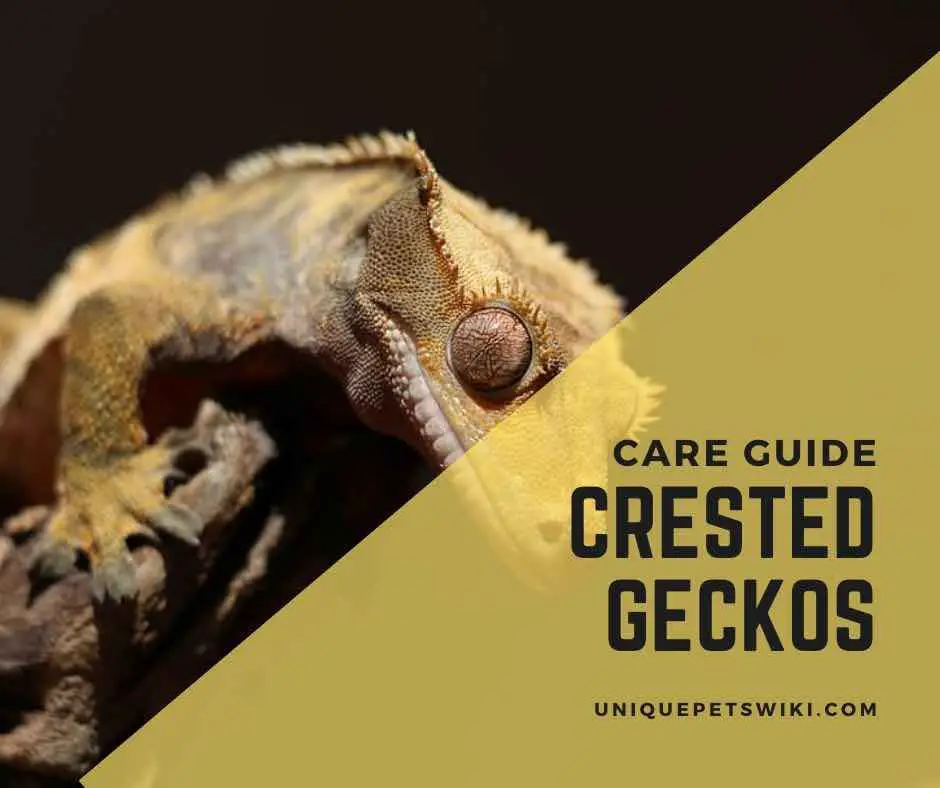Crested Geckos are regarded as one of the best beginner reptiles that you can keep as pets.
They are also called cresties. These are the hardy pets and will thrive well if kept in the right set-up.
You will surely find crested gecko a perfect pet for your household as it comes in different stunning colors and prices.
Another great thing about the gecko is that you don’t have to feed it live insects.
This is an added advantage if you are the type that does not like to feed your pet with live animals.
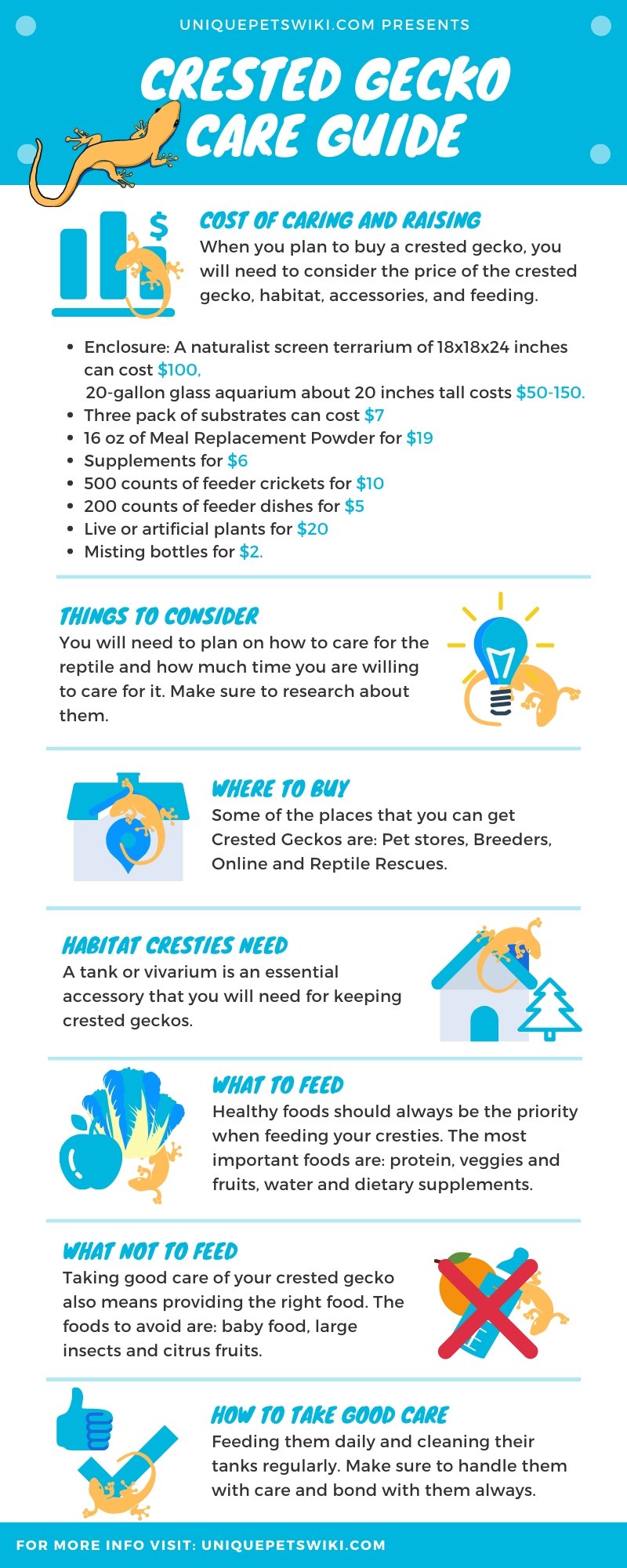
This article is about all the things you need to know before you decide to buy a crested gecko.
Our latest video
Contents
- What Are Crested Geckos?
- Why Do Crested Geckos Make Good Pets?
- 15 Fun Facts About Crested Geckos
- What To Look For When Buying a Gecko as a Pet?
- The Cost of Caring for and Raising a Crested Gecko
- Where Can I Buy a Crested Gecko?
- What Kind of Home Does My Crested Gecko Need?
- Things To Consider Before Buying a Crested Gecko
- The lifespan of Crested Gecko
- Crested Gecko Care
- Diet For Your Cresties: What Should I Feed My Crested Gecko?
- Diet For Your Cresties: What Should NOT I Feed My Crested Gecko?
- Daily Feeding and Cleaning Routine
- Handling and Bonding
- Shedding
- Bathing
- Brumation
- Cleaning the Habitat
- Physical/Behavioral Health Symptoms
- Geckos Substrate: What is the Best Substrate for Gecko?
- Crested Geckos Lighting: What are the Lights Need for Geckos?
- Crested Gecko Morphs
- Wrapping
What Are Crested Geckos?
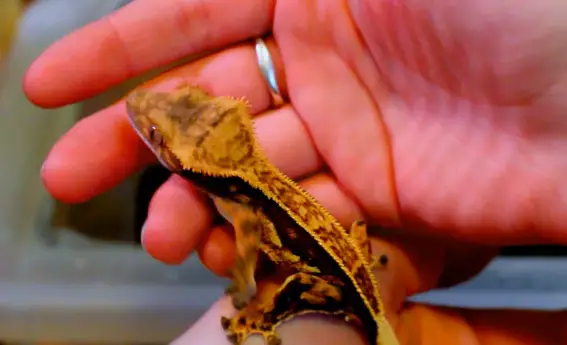
Appearance and Origin
Crested geckos are native to southern New Caledonia. They were thought to be extinct before they were rediscovered in 1994 on an expedition led by Robert Seipp. Cresties are considered to be among the largest gecko species out there.
It has a hair-like projection above the eyes that looks like eyelashes. Crested geckos feature two rows of spines that run from their heads down to the base of their tail. Their toes and tip of their tail are covered in small hairs.
The toes have small claws used for climbing surfaces that their toes cannot cling to. They come in different colors, which range from grey to yellow of various shades. In the wild, there are three color morphs of crested geckos known as tiger, patternless, and white-fringed.
Gender Differences and Mating
You can easily determine the sex of your crested gecko as they get older. Then, you will be able to identify the male crested gecko by its bulge.
The male crestie bulges when they are about 5-8 months, while some can go until 14 months.
Crested gecko breeding
The natural breeding cycle of crested geckos is 8-9 months, usually between March to September.
Before you start to mate them, you will need to ensure the male and female are sexually mature.
You need to ensure that the females are 18 months old and weigh around 35-40g. You should also ensure the female has enough calcium stores before you breed them.
When you are ready to mate crested geckos, you will keep the male and female cresties in a tank. You will need to be careful when you introduce the male as they can be quite aggressive and hurt the female.
The male will chase the female and mount her from behind. During mating, the male will also bite the head of the female multiple times.
You will also hear some weird sounds like squeaks while they are mating.
However, if you notice that the male bites the female’s skin and causes an open wound, you will need to remove the female.
You will then clean the wound with water before treating it with antibiotics until it heals.
You can then introduce the male again after the wound has healed. Crested geckos can mate only once or multiple times after you introduce the male to the female.
Pro tip: it is best to leave the pair for about a week before you remove the male.
Why Do Crested Geckos Make Good Pets?
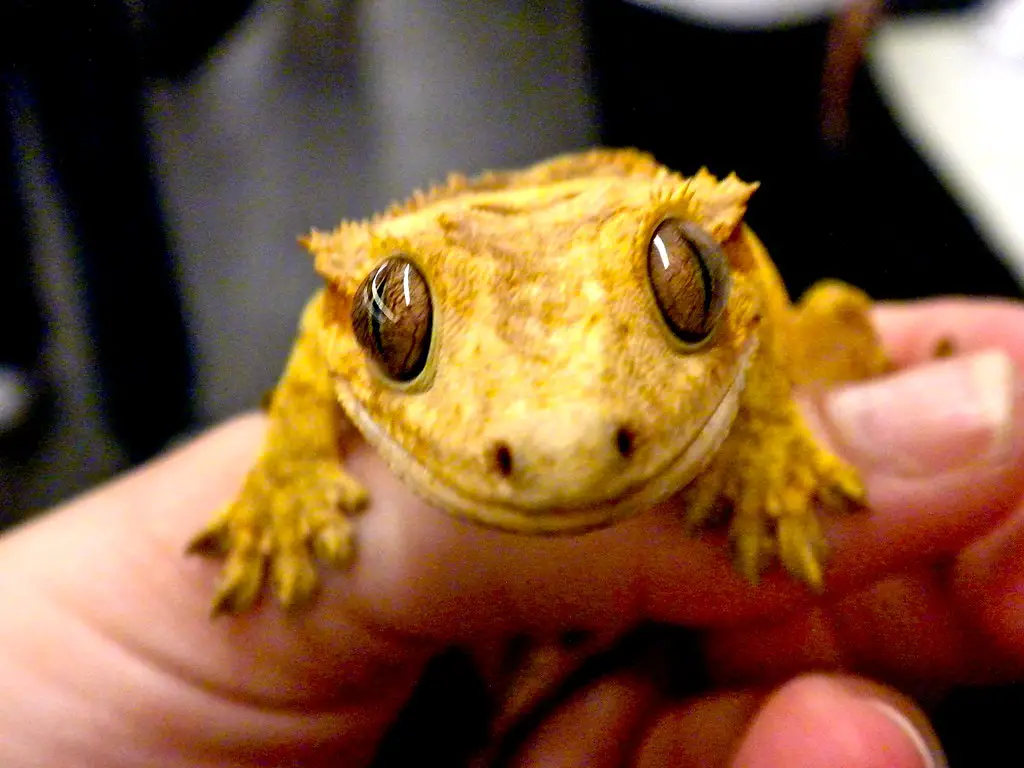
Crested geckos are available in a different range of colors and markings called morphs. Due to their docile temperaments, cresties are considered to be among the perfect reptile pets for beginners.
However, you will need to be careful when handling them as they can be a bit skittish.
Cresties are suitable for all kinds of reptile lovers due to the relative ease to care for them and their long lifespan.
Another thing is that all their accessories and food are readily available, and you can easily get them from your local stores or online.
15 Fun Facts About Crested Geckos
- Crested geckos are also known as eyelash gecko, New Caledonian crested gecko, and Guichenot’s giant gecko.
- Ciliatus, the specific name of crested gecko, comes from the Latin word Cilia. Cilia means fringe or eyelashes, and it is referring to the crest of the skin over the gecko’s eye that looks like eyelashes.
- They have small and fine hairs on their toe pads. These hairs help them to stick to surfaces and helps them when climbing the glass walls.
- Crested geckos lick their eyeballs to keep them clean and moist.
- They have a semi-prehensile tail, which helps them when climbing.
- Crested geckos can drop their tail as a deterrent to predators, but they won’t grow another back. This is my most crested geckos found in the wild because it lacks tails.
- They are vocal creatures and will make noises from time to time. They make sounds when stimulated or in breeding season or when they are stressed.
- Hatchling and juvenile crested geckos shed their skin once a week while adults shed their skin every one or two months. They will then eat up their shedded skin afterward.
- Crested geckos can grow to about 7-9 inches in length.
- Female cresties lay 2 eggs and will take them 2 to 5 months to hatch.
- Lifespan up to 10-20 years.
- First thought to be extinct before the end of the 20th century later discovered them.
- They are omnivores and can eat fruits and insects.
- Prefer making habitats in the rainforests.
- Crested comes in different colors, patterns, and morphs.
What To Look For When Buying a Gecko as a Pet?
Crested geckos are among the popular gecko kept as pets because they are easy to care for and have a long lifespan. Although you will find crested geckos at most of the pet stores, it is best to buy from a reputable breeder.
Before you buy a gecko, you can check if it is healthy. A healthy gecko does not have visible pelvic bones or ribs.
Geckos do not like to be handled, and it is best if you avoid handling them. Then they are rarely biting but can if they are stressed.
However, a crested gecko bite is not venomous or has much consequence.
The Cost of Caring for and Raising a Crested Gecko
When you plan to buy a crested gecko, you will need to consider the price of the crested gecko, habitat, accessories, and feeding. Some of the recommended supplies and their average cost are stated below.
- Enclosure: A naturalist screen terrarium of 18x18x24 inches can cost $100, 20-gallon glass aquarium about 20 inches tall can cost $50-150.
- Three pack of substrates can cost $7
- 16 oz of Meal Replacement Powder for $19
- Supplements for $6
- 500 counts of feeder crickets for $10
- 200 counts of feeder dishes for $5
- Live or artificial plants for $20
- Misting bottles for $2.
You should keep in mind that the above prices may vary between sellers. These costs should be yearly based on how each item is used. There is a need to feed cresties every other day while alternating with feeder crickets. When feeding with crickets, there is a need to provide supplements.
You will need to replace the live plants and the substrate. However, the cost of caring for a crested gecko is lesser than that of a dog. The cost of vet visits may arise while raising cresties, and you need to consider it as well.
How Much a Crested Gecko Cost?
The cost of buying crested geckos can vary based on the morphs, age, and sex. You will get cheap crested geckos from the chain stores as they are usually common morphs. You will need to budget $50-100 for hatchlings and juveniles, while male cresties can cost $100-250, and females can cost $200-400.
If you want a unique pattern or color, you will have to buy online or from a reputable breeder. You will then need to budget around $50 to $1000 for high quality and premium morphs. You can purchase crested geckos exceeding $1000 for breeding purposes and to reproduce rare breeds.
Terrarium Setup
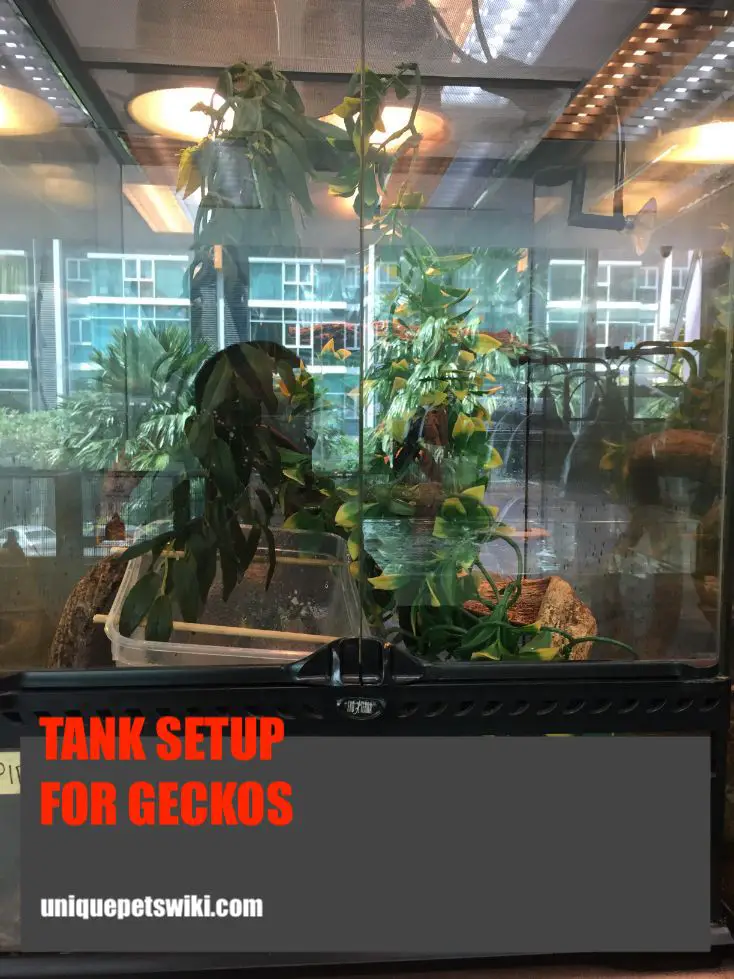
Crested geckos come from a mild to warm, humid environment. A tall glass tank with front and top ventilation can be used to prevent overheating.
You can provide a basking area around 75 degrees Fahrenheit as they can get stressed if warmer.
They are semi-arboreal animals and love climbing and staying off the floor. Their tank needs to be fitted with hardwood decorations to serve as alternative routes to climb up and down. They are a nocturnal animal, and you can provide them with a humid hides where they can hide and sleep during the day.
Cresties usually source their water from dew on leaves and flowers, and you will have to provide either real or artificial leaves and plants in their tank. Some of the other things needed are thermometer, hygrometer, feeding and drinking cups, etc.
Diet
You will need to feed your cresties with a healthy diet for their health and to increase their lifespan. When it comes to your crested gecko diet, you can go about it in two ways. They are by feeding with
- Insect and fruit-based natural diet, and
- Powder/granulate meal replacement diet
Insect and fruit-based natural diet: This is when you try to mimic crested gecko’s diet in the wild. Crested geckos are omnivores, and their diets in the wild are usually based on fruit and nectar.
Powder/granulate meal replacement diet: This is when you feed your cresties with commercial crested geckos foods and incorporate insects into their diet weekly. You can then add worms and fruit as a treat.
Cohabitation
Crested geckos are solitary animals and will love being held in the terrarium alone. Crested geckos live alone in the wild and will only encounter other cresties during the breeding season. This means your crested geckos will not suffer from lack of companionship if you house them alone.
Since cresties are solitary animals, forcing two or more geckos to live together can lead to disaster. This means they will be forced to compete for food, resources, and space within the tank. Adding another gecko into your crested gecko tank apart from breeding can cause stress.
Medical Costs
Crested geckos do not need regular checkups or annual vaccinations, unlike other pets. A visit to the vet with your crestie is usually when they get ill or gets injured. The cost of a vet visit with them is often around $40-$60.
However, you can pay hundreds of dollars when your cresties need x-rays, cultures, or other tests. You will not need to take them to vets for a long time, but you can budget medical costs for crested geckos around $200 per year.
Where Can I Buy a Crested Gecko?
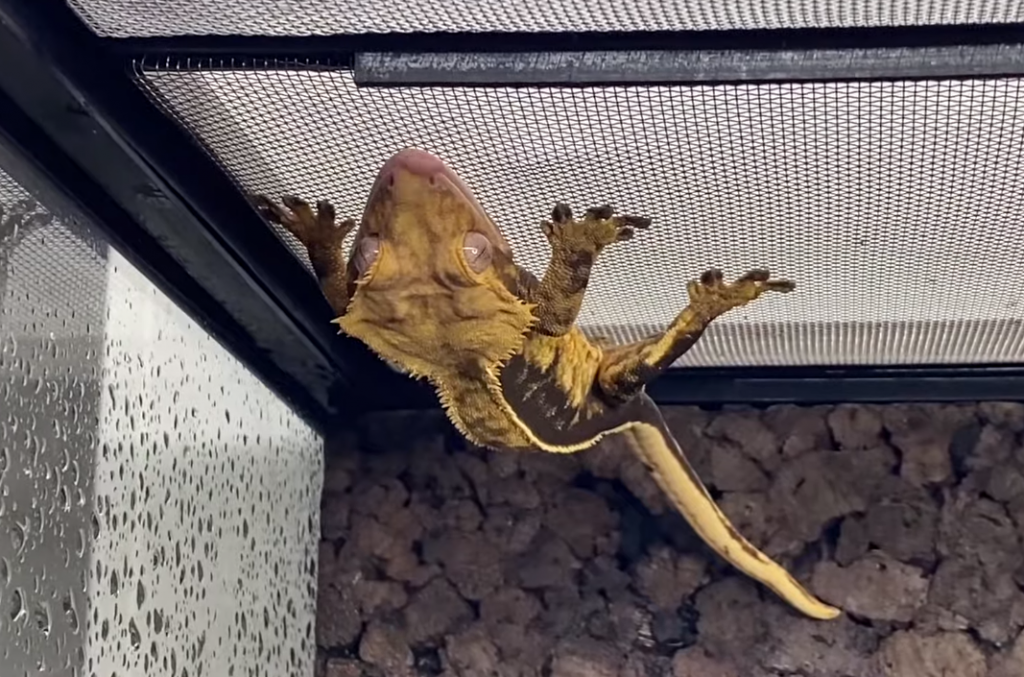
You can find crested geckos available for sale in almost any place in the world.
However, they are more popular in the United States, and you will easily be able to buy one if you live there. Some of the places that you can get crested geckos are stated below.
Pet Stores
Firstly, pet stores or shops sell a wide range of animals, and you will easily find crested geckos for sale. Pet stores are a popular and more accessible place to buy your first crestie but can be a bit expensive.
If you are buying your pet from a reputable store, you will get to see and handle it. You will also get care advice from the staff while you check if the price fits your budget.
Breeders
Buying your gecko from a private breeder is a perfect option if you know little about crested geckos. You can easily find private breeders by looking at classified ads and reptile groups on Facebook to find a reputable breeder close to your area.
You can then arrange to visit and talk with the breeder to ask everything you need to know about crested geckos. Another great thing about private breeders is that they have unique morphs that you will not find anywhere else.
Online
You will be surprised to find a huge online business that is selling crested geckos. Buying cresties online is an excellent option if you do not have breeders or pet stores selling them around you. You will find a wide range of morphs that you can buy.
The drawbacks of buying online are that you will not see the crested geckos before you buy it, you will not know whether they are healthy or not, and their living condition will be a mystery to you. However, you can contact the online sellers for answers to some questions you may have but cannot be like buying from a pet store or breeder.
Reptile Rescues
This is a budget-friendly option to buy crested geckos if you are on a budget. Getting crested geckos from reptile rescues or shelters also offer you the chance to provide a home for abandoned little cresties. However, you may not be able to choose your choice as they might be a limited number of cresties in the rescue.
Before you can then adopt them from reptile rescue, you may be asked to fill a form filled with different questions. These questions help to determine whether you can take care of the crested gecko.
What Kind of Home Does My Crested Gecko Need?
Tank/Vivarium
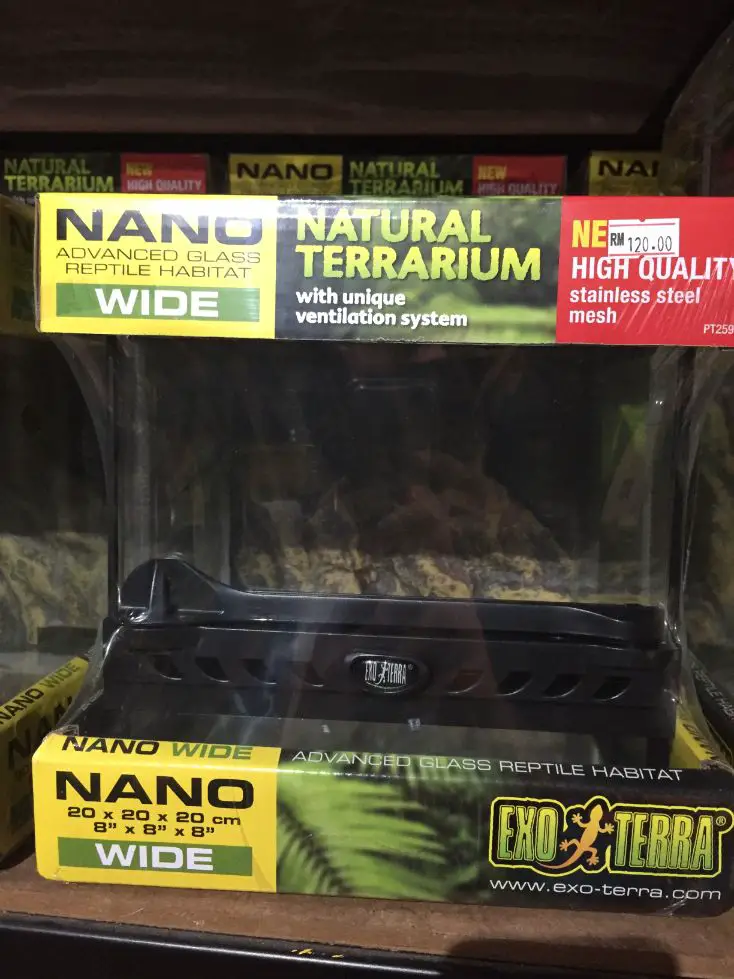
A tank or vivarium is an essential accessory that you will need for keeping crested geckos. Crested geckos do not take a lot of space, and you can keep the hatchlings in small containers or 10-gallon terrariums. You can then keep juvenile and adult cresties in about 20-gallon terrarium.
You can also buy special crested gecko habitats that are made by popular brands for your gecko. The dimension for a small crested gecko habitat is about 12x12x18 inches, while large crested gecko habitat is about 18x18x24 inches dimension.
Basking Accessories Like Branches, Rocks, and Hidey-Holes
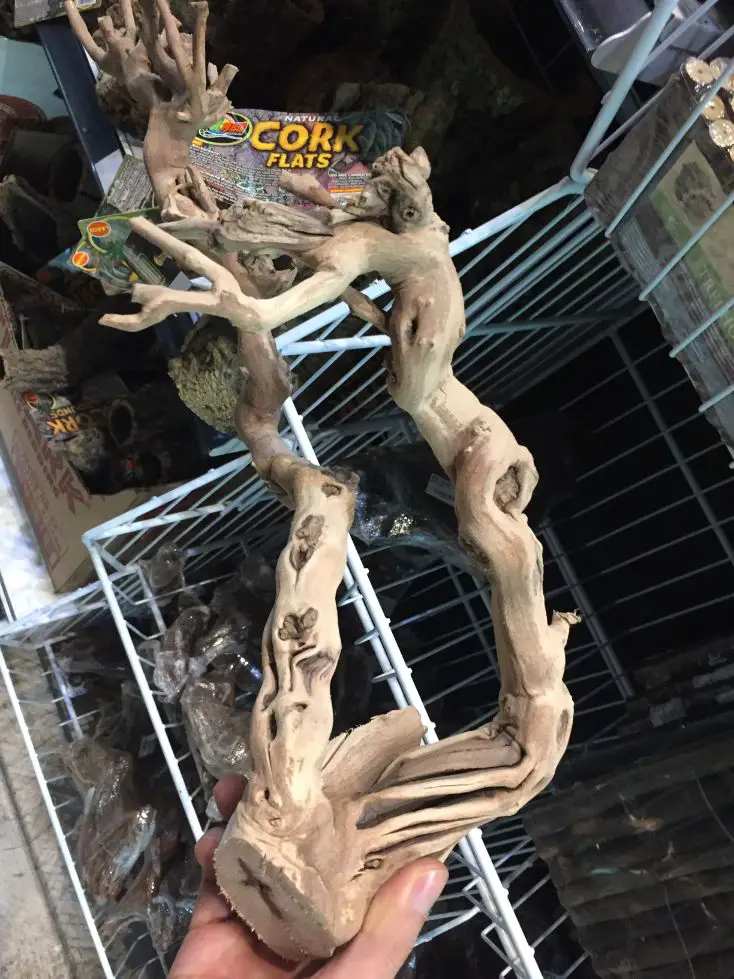
After getting a tank for your gecko, you will need a substrate that can promote humidity and easy to clean. Some of the best substrates are cypress mulch, coco bedding, orchid bark, patches of sphagnum moss, or a combination. Since cresties are nocturnal, you will provide a humid hides where they can snooze and hide during the day.
You can decorate the tank with plants with broad and flat leaves. The plant can then serve as a climbing structure within the tank and also as a basking spot for your gecko. You can also use driftwood, cork bark flats, and cork bark tubes with either live and artificial plants to decorate your gecko’s tank.
Dishes and Bowls
You can place crested gecko feeding cups or dishes on the ground. But it is best to put their feeding and water cups high since they are semi-arboreal animals. Investing in a feeding ledge is an excellent decision for most pet owners.
Feeding ledges can come with suction cups, magnets, or screws, and you can choose one that fits your gecko’s tank.
Things To Consider Before Buying a Crested Gecko
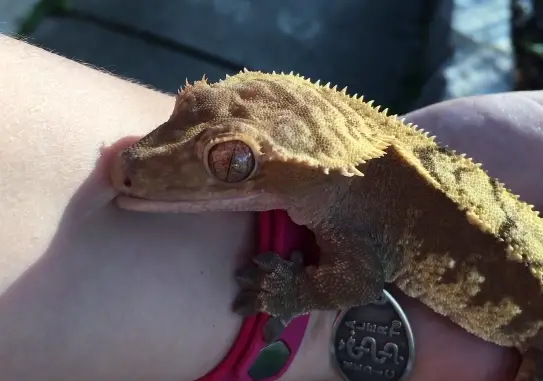
Buying a crested gecko should not be on impulse. You will need to plan on how to care for the reptile and how much time you are willing to care for it.
Crested geckos are relatively easy to care for, and it has an average lifespan of 15-20 years.
Some of the things that you can do before buying cresties are stated below.
Make Research About Them
You will need to educate yourself on the crested gecko behavior and care if you are a beginner.
You will need to learn about its care, nutrition requirements, health, and general behavior.
There are helpful books on crested geckos out there, or you can research them at the library and the internet. You can also consult with breeders and other keepers for more information.
You can also visit a local vet specializing in exotic animals so you can know more about the health issues that can come up with crested geckos.
Ensure Proper Space At Home
You will need to make sure there are proper spaces and conditions suitable for crested gecko at your home.
The habitat that you want to keep your gecko will then determine the space that you will need.
Based on space and budget, you can create a simple enclosure or a natural environment with an aesthetic feel.
Consider the Cost
Before you buy a gecko, you will need to consider the cost not only for the crested gecko but also for food and other accessories needed.
Some of the long-term cost is the cost of food, supplements, substrate, etc. and will add up easily over a year.
You will also consider the long-term commitment as they have a long life expectancy and require diligent care. You will need to clean their tank and feed them to avoid illness.
Crested Gecko Health Checklist
Although there are numerous important factors when you want to choose a gecko, the health tops the list.
It is also best if you buy your crested gecko from a reputable breeder or seller.
However, some of the things to look for in a healthy crested gecko are stated below.
- Active and alert
- Clear nose and vent
- Healthy skin with no unshed skin
- Straight tail without curves or kinks
- Eating regularly
- No visible ribs or pelvic bones
- Has straight spines, etc.
When choosing your crested gecko, you should keep in mind that they are nocturnal and may be sluggish during the day.
Therefore, it is best not to make this the sole indicator of their overall health.
Another factor that can change is the color of your crested geckos. Crested geckos color can change because of different reasons, which includes stress.
Their color can change as they age as the color of a hatchling is usually different when it reaches maturity. When you want to judge color, it is best to see the parent color.
The color of crested geckos is usually more vibrant at night than in the day.
The lifespan of Crested Gecko
A pet’s lifespan plays a huge role in getting and preparing for a pet.
Unlike other small pets, crested geckos have a long lifespan while in captivity, which is similar to larger pets like cats and dogs.
In the wild, the crested geckos’ lifespan is still a lot unexplored since they were just introduced as pets some decades ago.
It faces dangers in the wild such as diseases and predators.
However, some sources claim that it can live for around 4-5 years in the wild and that most geckos die in their first year.
In captivity, crested geckos can live for around 15-20 years.
It needs a long-term commitment, and it is best to decide from the start of this commitment.
Although predators cannot attack geckos in captivity, it can get sick or attacked by other pets in their enclosure.
Because of three major things, namely: genetics, care, and diet, your cresties can have a long life span.
Crested Gecko Care
Diet For Your Cresties: What Should I Feed My Crested Gecko?
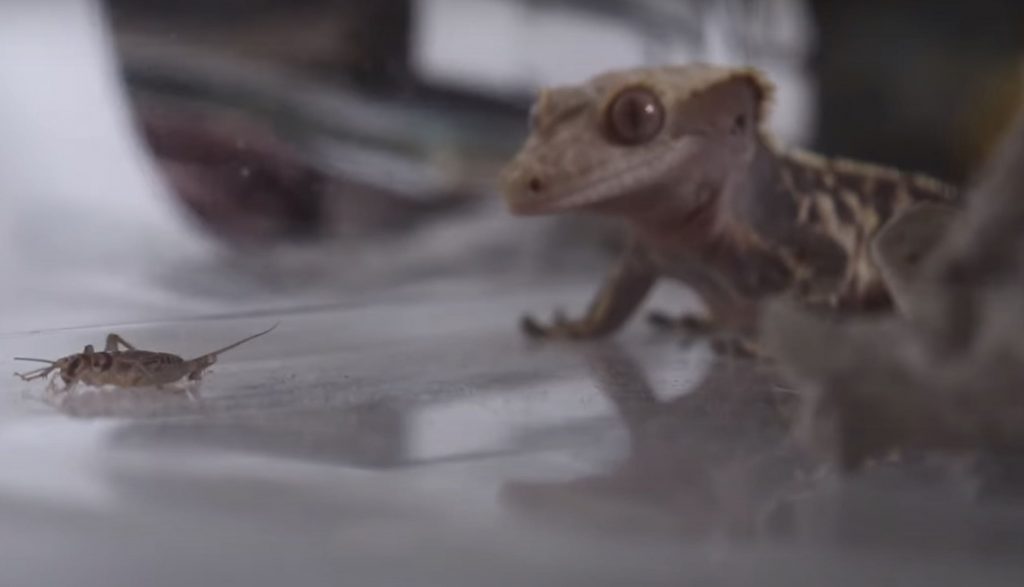
Crested Geckos are omnivores and will feed on both plants and animals.
Food Source
In the wild, it generally feeds on spiders, small lizards, insects, small birds, and small rodents. It can feed on plants like fruits and flowers.
Crested Geckos loves hunting and chasing food, and you can add crickets to their food in captivity.
In captivity, you can opt for a commercial crested gecko diet that provides a well-balanced and nutritious diet for them.
You can supplement the commercial diet with crickets and other prey insects, such as roaches, silkworms, waxworms, etc., to build their hunting instincts.
It is best to feed your geckos in the evening.
You should try to feed juvenile geckos daily while adults can be fed just three times a week. If you are planning to feed your gecko with prey, ensure that the prey is smaller than the space between the gecko’s eyes.
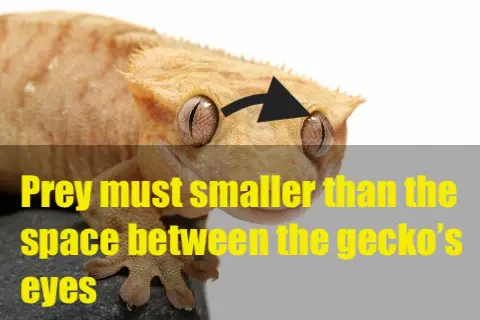
The prey should be gut loaded before you feed the gecko, also dust it with calcium and vitamin D3 supplement 2-3 times a week.
Vitamin Needed
Animals usually synthesize vitamin D from sunlight in the wild. The skin of animals then helps to convert the ultraviolet light into Vitamin D3.
Although many people believe that crested gecko is nocturnal and does not need vitamin D3, you need to supplement about 4,000 IU/KG of vitamin D3 in their diets.
You can include vitamins into their diet by feeding your geckos with a commercial crested gecko diet.
However, if you are feeding your geckos with insects, you will need to supplement vitamins into their diet. Remember that you need to feed your geckos with prey smaller than the space between its eyes.
The prey will then be gut loaded and then dusted with vitamin D3 before you feed it to your geckos. Add Vitamin D3 supplements 2-3 times a week into their food is a good idea.
Calcium Powder Supplements Needed
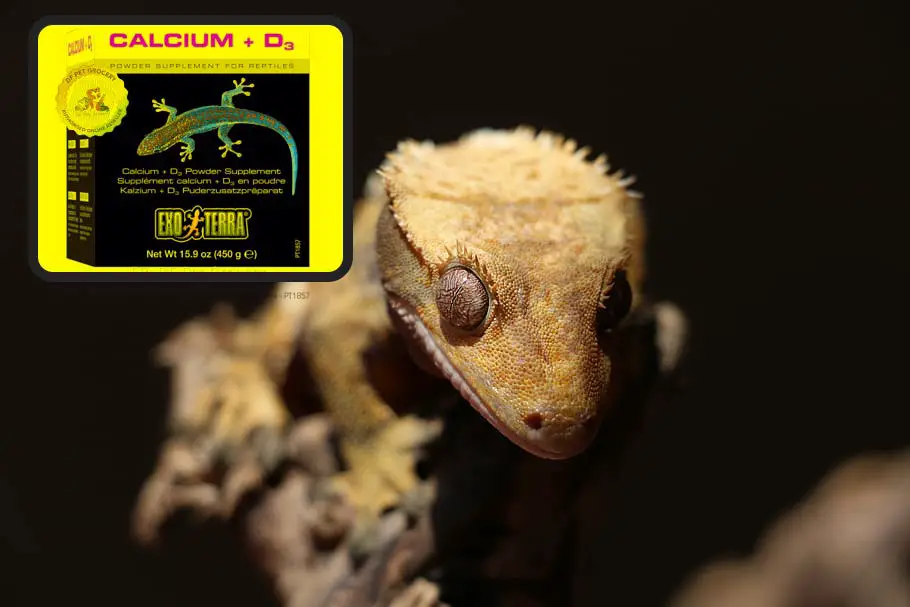
Crested geckos need calcium not only for its bone strength but for proper body functionality.
You will notice that most of the reptile supplements out there have calcium but little or no vitamins and minerals.
If you want a balanced meal for your pet, it is best to opt for a commercially prepared powdered diet.
With a commercially made powdered diet, you will not have to calculate the calcium to phosphorus ratio or worry about not providing a balanced diet for your pet.
Adding these powdered diets with live insect feeders when you are feeding your gecko is not a must if you can train your cresties to eat calcium powder.
Protein
The protein source for crested geckos is the insects. However, the commercially raised insects are deficient in several nutrients like Vitamin A, B1, E, and calcium. Before you decide to feed your cresties with insects, you will need to gut-load them with high calcium and vitamin A diet.
You should also feed them with insects low in fat content. Some of the insects that you can feed your cresties are crickets, roaches, soldier fly larvae, etc. You should feed them with mealworms, waxworms, super worms sparingly because of their fat content.
Veggies and Fruit
Vegetables are fiber-rich plants that are filled with numerous vitamins and can improve the overall health of anybody that feeds on them. Crested geckos have shorter digestive tracts with no functioning caecum, which means they cannot consume many vegetables. It is best to feed vegetables to them occasionally to avoid problems.
In the wild, crested geckos live mostly on a fruit-based diet, and it is best to give them fruit only as a treat. You can give them soft fruits that are high in calcium and low in phosphorus. Some of the fruits that you can give them are papaya, apples, pears, watermelons, cantaloupes, figs, bananas, grapes, berries, figs, etc.
Water
An essential part of crested gecko care is water. They need water for proper hydration to promote complete sheds and keep them healthy. You can use a shallow dish to provide water for them. You can also provide them with water by daily misting of their habitat.
Dietary Supplements
You will need to provide your geckos with vitamins and mineral supplements if you are offering them insects and worms. You can provide supplements by either gut-loading or dusting the insect.
Gut-Loading: This involves feeding the insects with extra nutrients a day before you feed them to your crested gecko.Dusting: This involves coating the insects with calcium and vitamin supplement before you feed them to your crested gecko.
Diet For Your Cresties: What Should NOT I Feed My Crested Gecko?
Baby Food

Most crested gecko owners use baby food for feeding their crested geckos before meal replacement powders came into the market.
They used the fruit-based baby food to replace fresh fruit.
Fruit-based baby foods consist of a mix of chicken and fruit or meat baby food with a ratio of 4 part fruit and 1 part chicken or meat.
However, baby food needs to be supplemented with vitamins and calcium supplements.
It is bad for crested geckos due to the high amounts of sugar, additives, and preservatives.
It is best if you avoid baby food and look for healthy alternatives like meal replacement powders.
Large Insects
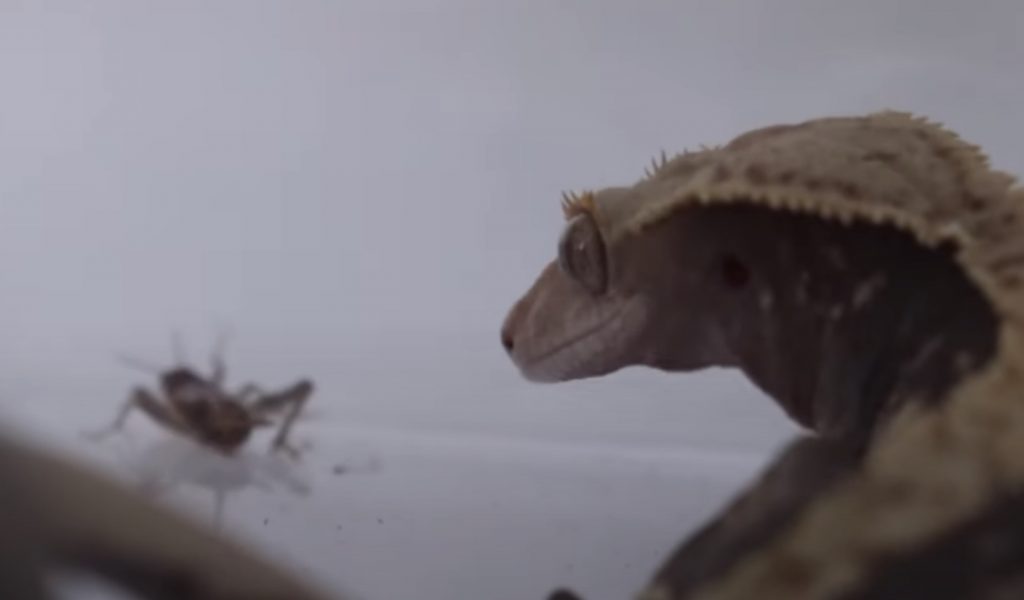
Insects are a perfect diet supplement for your crested gecko, and it helps to develop your cresties hunting skill.
However, you need to make sure that the insects are not too big for your gecko.
Always make sure that the insects are not larger than the space between your gecko’s eyes before you feed it to your crested geckos.
Citrus Fruits
Citrus fruits are considered harmful to crested geckos because it contains citric acid. However, you can give it to your cresties as treats once a month.
Daily Feeding and Cleaning Routine
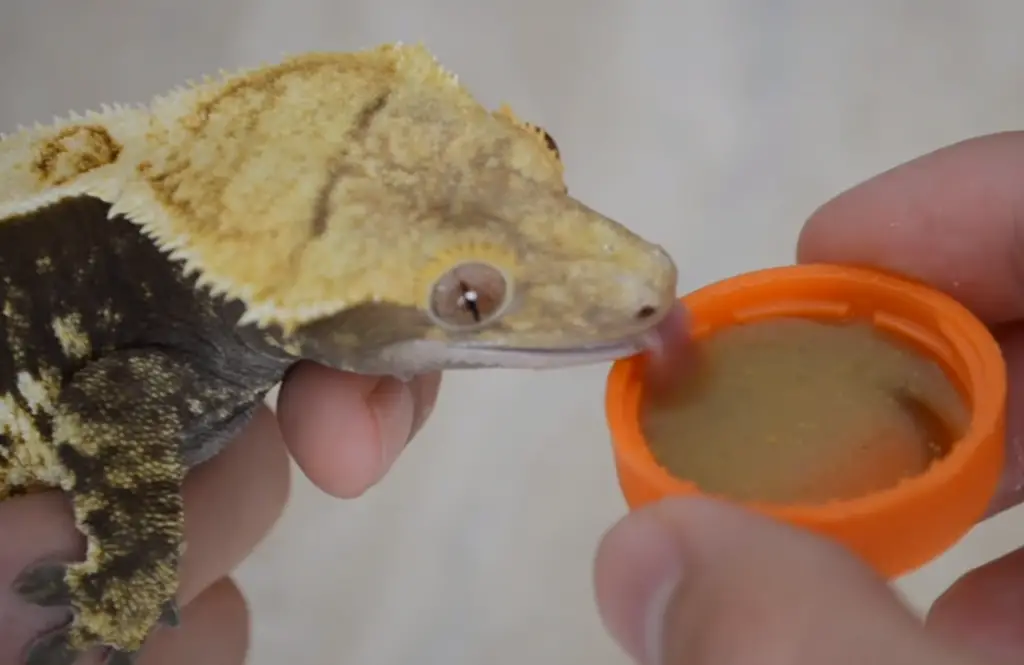
You can feed baby crested gecko with fresh premix food every other day. You can leave the leftover before you change to a fresh batch.
Read more about how often baby crested gecko eat
This gives them the option to eat whenever they need it.
You can feed juvenile and adult crested geckos every other evening during the week with premixed powder. However, you will need to remove the leftovers the following morning.
Read more about how often juvenile crested gecko eat
During the weekend, you can feed them with live food to improve their hunting skill. You can then rotate the process the following week by feeding with live food twice a week and premix during the weekend.
Handling and Bonding

Although crested geckos are among the easiest lizards that you can handle, they can get upset or stressed out easily. It is not hard to handle them, but you will need to be careful while handling them.
Handling Tips
When your cresties are setting in, try to replace their food and water in the late afternoon while they are asleep to reduce stress. You can replace their paper towel weekly while you also incorporate handling in their routine slowly.
It is best to handle jumpy gecko during the day as it will be more alert at night and can run away. You can use a technique known as hand walking where you let your gecko run or jump from one hand to the other. When hand walking them, ensure that it is just for some minute or two every other day after they have settled.
You can then increase to about 15 minutes. After some months, your gecko might get used to it during the evening, but you should expect them to run away. However, most geckos get tame down within a month, but you might have a gecko that does not tolerate handling or is always jumpy.
Shedding
Crested geckos will occasionally shed their skin just like other reptiles.
Baby crested geckos shed their skin more frequently as they grow but will slow down as they grow older.
They usually shed their entire skin at once and will eat their shed afterward.
This is because new skin production consumes lots of their vitamins and calcium levels and will eat up their shed to make up for the loss.
Although shedding is not a problem for cresties, it may encounter a problem if they are not properly cared for.
During shedding, some of the important factors for successful shedding is adequate humidity and hydration.
Bathing
Crested gecko hardly needs baths, as maintaining a correct humid environment is enough for them. You will be causing more stress for them if you bath them.
However, there are situations when you need to give a sauna to your gecko, especially when they get overheated.
A sauna is usually providing a little amount of standing water to hydrate their skin. When giving a sauna bath, ensure that the water is not too hot or too warm as it can cause heat stroke or harm them when exposed to high temperatures.
Brumation
Your crested gecko will bromate when the temperatures and amount of daylight are low. Some of the signs to show your crested gecko is bromating are
- Sleep more
- Less active
- Stays in its hide for most time
- Does not poop
The general brumation period for crested geckos is between 21-30 days.
During this period, you will need to weigh them every three to four days to ensure they do not experience weight loss.
If it experiences considerable weight loss, you can break the brumation period and ensure they get back on track while gaining enough weight.
When ending a brumation period, you will need to slowly raise the temperature and amount of daylight for two weeks until their tank reaches the normal summertime temperature.
You will also provide them with food every other day after brumation, although most geckos will eat immediately after the brumation period; some need more time before they start eating.
Once your cresties get back to summertime temperature, it should start eating.
Cleaning the Habitat
It is recommended to clean your gecko’s cage every day. You will need to mist the paper towels at night to maintain high humidity.
At least once in a week, you will change the paper towels and clean the décor.
However, you should make sure that you clean the tank and replace the substrate at least once a month.
Physical/Behavioral Health Symptoms

All about crested gecko health issues, illnesses
Dehydration
Cresties can suffer from dehydration and can lead to death in a short time. You will need to provide them with a water bowl and mist their enclosures every night.
You can also use plexiglass panels to cover 50% of the screen to retain moisture.
Another beneficial accessory is by providing a lay box or humid hide. If you are keeping your geckos in a plastic tub, ensure there is adequate ventilation.
However, too much moisture can lead to respiratory problems and mold growth in their tank. It is recommended to use water bowls with light spraying to keep them hydrated.
Diarrhea
Crested geckos can have diarrhea due to several reasons like stress, parasites, change in diet, and shedding.
Most times, runny poop can easily be resolved based on the cause.
Runny poop can be as a result of introducing your cresties to a new home. This will pass once they settle in as long as they are growing and active.
Diarrhea of cresties because of shedding will also pass within a few days.
Runny poops can also be caused by high humidity above 70%, and by letting the tank dry a little will solve this. Diarrhea can also occur when cresties are infected with parasites or fed with fruits high in fiber.
Impaction or Constipation
This usually occurs if you feed your gecko with large feeder bugs or ingest loose substrate in their tank.
Crested geckos will have problems digesting large feeder insects and may get stuck in their intestines. They can have impaction if you feed them with bugs that have hard chitin or sharp legs.
If your gecko experienced impaction, ensure that you keep a cup of water with them.
You will need to mist the enclosure once a day and also feed them with high fiber fruit. You can also massage their belly.
Geckos Substrate: What is the Best Substrate for Gecko?
The suitable substrate for crested geckos needs to retain moisture and helps to maintain the humidity levels of its enclosure.

You also need to get a substrate that is clean as well. Some of the best substrates that you can use are moss, orchid bark, cypress mulch, coconut fiber bedding, or peat, and you can also use paper or paper towels.
If you have crested geckos that ingest substrate while hunting, you should opt for moss or paper towels substrates. It is best if you use paper towels substrate for juvenile geckos because they can accidentally swallow other substrates.
In their tank, you also need to provide resting and activity areas for your geckos.
It is best to provide an excellent landscape material that includes cork bark sections that can be used for vertical and ground level shelters and a climbing area.
Crested Geckos Lighting: What are the Lights Need for Geckos?
Reptiles such as crested geckos are ectotherms, which means its body temperature is different from its environment.
It is best to provide your geckos with a suitable temperature range for feeding and several other activities.
You will also need a thermometer to record the accurate temperature of its tank.
The suitable day temperature for crested geckos is between 78-82°F.
However, it can drop to about 70°F during the night. The best way that you can provide heat for your crested geckos is with a low-wattage incandescent bulb or ceramic heat emitter.
You will need to keep a side of the tank unheated, so your geckos can use the cooler area to regulate their body temperature. Using of a sub-tank reptile heat pad or heat pad under a tank side that is regulated by a thermostat is a great option for it.
You can add additional light by a fluorescent bulb that runs through the length of your tank if you have live plants in your tank.
You do not need to provide UVB light for your gecko if their diet contains Vitamin D3.
Crested Gecko Morphs
Crested geckos offer pet lovers a wide range of cute color & morphs as it comes in a wide range of pattern, color, and traits.
This means there is a wide range of options to choose from. Some of the popular crested gecko morphs are stated below.
Patternless or Solid Crested Gecko
A patternless or solid morph, as its name implies, means a crested gecko does not have a pattern.
It has a solid color, but you may notice a row of cream-colored scales around the back of the hind legs. You will find patternless morphs in different colors like brown, olive, orange, dark brown-black, yellow, red, and cream.
Bicolor Crested Gecko
Bicolor Crested gecko has two colors. One is a base color while the other is lighter, and you will find it running along the back or dorsal part of the gecko.
Bicolor morphs can come in a different color, just like patternless morphs, but there is a contrasting pale hue around the dorsal area.
Tiger Crested Gecko
Tiger morphs have a light base color and a darker band that runs vertically from the dorsal part down to the sides of the gecko.
Although you will find these morphs in different colors like patternless and bicolor, it is usually in a shade of beige or brown.
Brindle Crested Gecko
This is another morph of crested gecko that looks like the tiger morphs. However, the bands of patterns do not run up and down but are broken and have a marble look.
Flame Crested Gecko
Flame crested geckos morph looks like bicolor morph, but their base color has a more defined lighter color along its back.
The main difference between flames and bicolor is that the secondary color is more contrasted and is lighter than the base color. Flames crested gecko has little or no pattern on its laterals or limb part.
Harlequin Crested Gecko
Harlequin crested geckos look similar to flames gecko but have more patterns. You will see more pattern along its sides and legs, and it comes in a wide range of colors.
Another morph is the extreme harlequin, which is even with more color, and there is a contrasting color on the upper lateral area.
Pinstripe Crested Gecko
Pinstripe crested gecko has raised scales that run down the entire length of their body, connecting to the tail.
The raised scales may be highlighted with cream color or not.
Pinstripe crested gecko has many different morphs like cream pinstripes, reverse pinstripes, partial pinstripe, quad pinstripes, and phantom pinstripes.
Furry Crested Gecko
A furry crested gecko features raised scales around the edges of the dorsal area.
They have raised scales just like the pinstripe crested geckos, but it is in a more sporadic arrangement.
Dalmatian Crested Gecko
This is a popular trait on most of the crested geckos, no matter the visible traits. You will find dalmatian spots in varying sizes on the gecko’s body.
The dalmatian trait usually does not show during a young age but will show as the gecko develops with age.
Some of the other morphs of crested geckos are lavender crested gecko, drippy crested gecko, solid back crested gecko, tricolor crested gecko, creamsicle crested gecko, white wall crested gecko, and Halloween crested gecko.
Wrapping
Crested geckos use their prehensile tail to wrap around objects such as vines and branches and are used for maintaining their stability. They also use it to wrap around their owners’ fingers while handling them.
However, the crested gecko can drop or self-amputate their tail when they are stressed or threatened.
Unlike some geckos, crested geckos cannot regenerate their tail once it is dropped.
In the wild crested geckos drop their tails to wriggle away from predators.
This is why most of the adult geckos found in the wild do not have tails.
You will need to keep your gecko healthy, make sure their environment is stress-free, and handle them gently so that it will not drop its tail in captivity.
